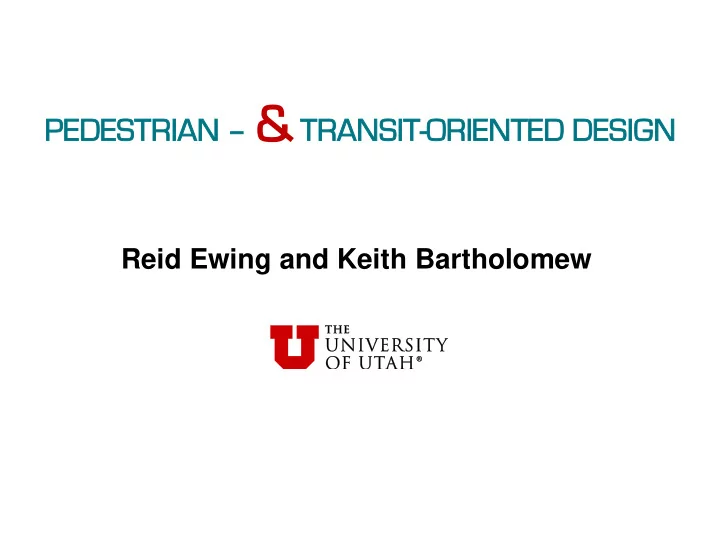

RIAN – & TR PE PEDE DEST STRIAN TRAN ANSIT SIT-ORIEN ORIENTED TED DE DESIGN SIGN Reid Ewing and Keith Bartholomew
Design, Not Planning
Decomposed Urban Design Great Place 8 Urban Design Qualities 28 Physical Features
Evidence-Based • Travel-Built Environment Studies • Visual Preference Surveys • Hedonic Price Studies • Traffic Safety Studies • Transit-Oriented Design Manuals
Bonuses • Photos by Dan Burden • Code Examples by Sara Zimmerman
Chapter 1 - Introduction
Demand for Walkable, Transit-Oriented Development Will Only Increase
Ch Chapt apter er 2 - Ur Urba ban n Desi sign gn Qual ualities ities
Quantifiable Relationships
Imageability • Imageability is the quality of a place that makes it distinct, recognizable, and memorable. A place has high imageability when specific physical elements and their arrangement capture attention, evoke feelings, and create a lasting impression.
Enclosure • Enclosure refers to the degree to which streets and other public spaces are visually defined by buildings, walls, trees, and other vertical elements. Spaces where the height of vertical elements is proportionally related to the width of the space between them have a room-like quality.
Human Scale • Human scale refers to a size, texture, and articulation of physical elements that match the size and proportions of humans and, equally important, correspond to the speed at which humans walk. Building details, pavement texture, street trees, and street furniture are all physical elements contributing to human scale.
Transparency • Transparency refers to the degree to which people can see or perceive what lies beyond the edge of a street or other public space and, more specifically, the degree to which people can see or perceive human activity beyond the edge of a street or other public space
Complexity • Complexity refers to the visual richness of a place. The complexity of a place depends on the variety of the physical environment, specifically the numbers and kinds of buildings, architectural diversity and ornamentation, landscape elements, street furniture, signage, and human activity.
Coherence • Coherence refers to a sense of visual order. The degree of coherence is influenced by consistency and complementarity in the scale, character, and arrangement of buildings, landscaping, street furniture, paving materials, and other physical elements.
Legibility • Legibility refers to the ease with which the spatial structure of a place can be understood and navigated as a whole. The legibility of a place is improved by a street or pedestrian network that provides travelers with a sense of orientation and relative location and by physical elements that serve as reference points.
Linkage • Linkage refers to physical and visual connections from building to street, building to building, space to space, or one side of the street to the other which tend to unify disparate elements. Tree lines, building projections, marked crossings all create linkage.
Recommend
More recommend